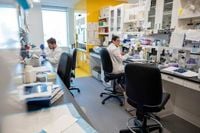On March 28, 2025, the CHU de Québec – Université Laval inaugurated the research center of its new hospital complex, located at the Hôpital de l'Enfant-Jésus site. This significant event marks a milestone in the delivery of the pavilions that will make up the new hospital complex, which is being constructed at a cost of $90 million. The five-story pavilion consolidates research teams that were previously spread across three buildings associated with the Hôtel-Dieu de Québec.
Approximately 30 researchers from Université Laval and their teams are already utilizing the new facilities, which encompass around 11,000 square meters of floor space. In total, 250 people are engaged in research activities across various fields, including oncology, endocrinology, and nephrology. The design of the spaces promotes collaborative work among teams, enhancing the potential for innovative discoveries.
The new research center is strategically located adjacent to the cancer center, facilitating the integration of research and clinical activities, as well as fostering synergy between research teams and healthcare staff. Serge Rivest, director of the Centre de recherche du CHU de Québec – Université Laval, expressed pride in the project, stating, "In 2012, we convinced government officials of the importance of including a research center in the new hospital complex project. Our vision was to focus on the medicine of the future, including gene therapies and stem cells, to develop targeted therapies based on patients' genomic profiles. Another element of our vision was to be close to the patients. Here, fundamental science researchers see the patients being treated at the cancer center, and the patients see the researchers working on developing future therapies."
Sophie D'Amours, the rector of Université Laval, praised this vision, emphasizing the university's commitment to fostering a virtuous circle of education, research, and knowledge transfer. "The link between fundamental research and clinical research, along with collaboration among researchers, student-researchers, and physicians, will enable faster development of better treatments for patients while ensuring the training of individuals whose talents will be recognized worldwide," she noted.
Rivest, who has visited numerous research centers globally over the past 30 years, described the new facility as extraordinary. "I’ve seen many research centers around the world, and very few of them can compare to this one," he said. He emphasized the importance of visibility for patients, explaining, "I wanted it this way because patients can see from their windows what researchers are doing. They can see the therapies of the future that may help them heal."
Nearly 200 individuals work under the guidance of 50 fundamentalist professor-researchers at the center. These researchers conduct pure and rigorous science, while adjacent to them are clinical researchers, surgeons, radiation oncologists, pharmacists, and nurses. Martin Beaumont, the CEO of the hospital center, acknowledged the challenges of bringing together such diverse expertise in one location but stressed its necessity for pushing the limits of science to help people heal and live longer.
Beaumont remarked, "Instead of everyone working like a rake, we’ve created a big squeegee. When we work in silos, it’s less effective. Here, students and researchers are close to the clinic, and clinicians can interact with researchers. This gives us the chance to have better treatments and to develop them more quickly. This center is unique in Canada."
Rivest is confident that significant discoveries will emerge from this new research center, particularly in oncology and nephrology. The CHU estimates that patients will require fewer visits to the hospital since nearly all services will be provided within this mega-hospital, which will extend from 18th to 24th Street in the Maizerets neighborhood. This new complex is set to serve Eastern Quebec, reaching as far as the Magdalen Islands and parts of New Brunswick.
Beaumont highlighted the center's world-class status, stating, "The research center and its proximity to the clinical service center are an incredible lever of attractiveness. We are well-positioned to attract talent that has left the province. Come back home, and we will be able to showcase your expertise." He conveyed hope for young researchers, saying, "We tell our youth that they can work here with international researchers. You won’t have to expatriate. That’s hope. And people will be treated better and will see their lives extended."
Rivest designed the research center to inspire those who work there, incorporating large windows to ensure bright laboratory environments and a coffee room with mountain views. The fifth floor is dedicated to teaching. He expressed optimism about the future, stating, "Great things will happen here. This building allows us to be at the cutting edge of technology and to be world-class researchers. Without this environment, researchers will go elsewhere, claiming it’s better in Toronto or Paris. They won’t do that here."
Rivest also mentioned the acquisition of a cyclotron, a device used to produce nuclear substances, which attracted a radiopharmacist from Saskatchewan along with their entire team. Beaumont noted, "The City of Quebec did not see the cyclotron as a small gadget for research but as a significant economic and attractiveness project." Rivest humorously recalled how he convinced former Mayor Régis Labeaume to fund the cyclotron by pointing out that Sherbrooke had two.
Despite a setback in February 2023, when water damage occurred in the professorial wing just days before staff were to move into the research center, the project remained on track. Rivest recalled the emotional toll of that incident, saying, "I remember, I cried. We were so close to moving in." Fortunately, the damage was limited to offices, and the laboratories remained unaffected. Insurance covered the costs of the incident, which delayed the researchers' move by nearly a year. They finally settled into the new facility in December 2024.
Robert Topping, director of the NCH project office for the Quebec Infrastructure Corporation, assured that they adhered to project parameters for both costs and timelines, despite minor setbacks. The research center represents a $90 million investment within a total budget of $2.24 billion for the new hospital complex, which aims to combine the expertise of the Hôtel-Dieu de Québec and the Hôpital de l'Enfant-Jésus. All work is expected to conclude by 2029, with critical care activities starting in a new $1 billion pavilion in 2027.
The official name of the new hospital complex will be determined after upcoming public consultations.





